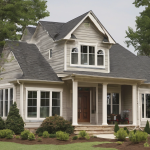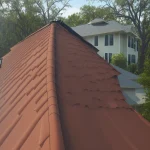Oregon Home Exterior Harmony: How Roof Material Impacts Window and Siding Selection
Oregon’s Exterior Equation: Roof, Windows, and Siding
In Oregon, where the landscape ranges from the misty coast to the arid high desert, a home’s exterior is its first line of defense against the elements. But it’s also a statement of style. The roof, often overlooked, plays a pivotal role in dictating the best choices for windows and siding. This isn’t just about aesthetics; it’s about creating a cohesive, durable, and energy-efficient home that stands the test of time and Oregon’s diverse weather patterns.
Choosing the right combination of roofing, siding, and windows is an investment in your home’s longevity and curb appeal. This article explores the crucial relationship between these elements, providing Oregon homeowners with the knowledge to make informed decisions. Consider the interplay of materials: the color and texture of your roofing materials significantly influence the optimal siding options and window selection. For instance, a classic Craftsman-style Oregon home with asphalt shingles might benefit from wood siding and wood windows, enhancing its traditional charm.
Conversely, a modern home featuring sleek metal roofing could be complemented by fiber cement siding and aluminum windows, creating a contemporary aesthetic. The key is to establish a visual harmony that reflects the architectural style while providing optimal weather resistance and energy efficiency. Ignoring this crucial relationship can lead to a disjointed appearance and compromised performance. Beyond aesthetics, the practical implications of material choices are paramount, particularly concerning Oregon’s diverse climate zones. In the Willamette Valley, moss resistance is a critical factor when selecting roofing materials like asphalt shingles or wood shake.
Pairing these roofing choices with siding and windows that can withstand moisture is crucial. Coastal Oregon homes demand siding options like vinyl siding or fiber cement siding that can endure salt spray and high winds, coupled with impact-resistant windows. In the High Desert, UV protection is essential for both roofing and siding to prevent fading and cracking, making materials like tile roofing and UV-resistant wood windows ideal choices. Understanding these regional nuances ensures a durable and long-lasting home exterior.
Ultimately, the goal is to create a home exterior that not only looks beautiful but also performs optimally in Oregon’s unique environment. Thoughtful window selection, combined with durable siding options and appropriate roofing materials, is an investment that pays dividends in energy savings, reduced maintenance costs, and increased curb appeal. By carefully considering the interplay of these elements and tailoring your choices to your specific climate zone, you can create an Oregon home that is both stylish and resilient. A well-coordinated home exterior significantly enhances property value and provides lasting comfort and protection for years to come.
Asphalt Shingles: The Versatile Foundation
Asphalt shingles reign as the most prevalent roofing material for Oregon homes, largely due to their attractive blend of affordability and straightforward installation. This makes them a popular choice for homeowners looking to balance cost and functionality. Their inherent versatility also allows them to seamlessly integrate with a diverse array of architectural styles, from the classic ranch to the contemporary craftsman. Available in a wide spectrum of colors and profiles, asphalt shingles provide ample opportunity to enhance a home’s curb appeal without breaking the bank.
However, prospective homeowners should be aware of their limitations, including a relatively shorter lifespan, typically ranging from 15 to 30 years, and a susceptibility to moss and algae growth, particularly in the wetter climates of the Willamette Valley and Coastal Oregon. This necessitates regular maintenance to preserve their aesthetic appeal and protective qualities. While asphalt shingles offer an economical entry point into roofing, their long-term cost-effectiveness should be carefully considered. The need for more frequent replacement compared to materials like metal or tile can offset the initial savings.
Furthermore, their lower energy efficiency can translate to higher heating and cooling costs over the lifespan of the roof. In Oregon’s diverse climate, selecting the right type of asphalt shingle is crucial. Options like architectural or dimensional shingles offer enhanced weather resistance and a more visually appealing texture, while those with algae-resistant granules can mitigate the moss problem common in wetter regions. Thoughtful selection can help maximize the lifespan and performance of asphalt shingles, making them a more sustainable choice for Oregon homeowners.
When pairing asphalt shingles with siding and windows, homeowners have several options to create a cohesive home exterior. Vinyl windows and siding present a budget-conscious approach, offering a clean and consistent aesthetic. Fiber cement siding provides a step up in durability and visual appeal, mimicking the look of wood without the associated maintenance. For those seeking a warmer, more traditional look, wood windows and siding can be incorporated, but require a commitment to regular upkeep to combat moisture and pests. Aluminum windows offer a durable, low-maintenance alternative. Ultimately, the best window selection and siding options will depend on the homeowner’s budget, desired aesthetic, and willingness to invest in long-term maintenance, carefully balancing cost, curb appeal, and weather resistance for their Oregon home.
Metal Roofing: Durability and Modern Appeal
Metal roofing, particularly standing seam metal, is experiencing a surge in popularity among Oregon homes, driven by its exceptional longevity, often spanning 40 to 70 years. This extended lifespan translates to long-term value, minimizing the need for frequent replacements common with other roofing materials. Beyond its durability, metal roofing offers superior fire resistance, a critical advantage in regions prone to wildfires. Its inherent energy efficiency also contributes to lower utility bills, as metal reflects solar radiation, keeping homes cooler in the summer months.
The sleek, modern aesthetic of metal roofing complements contemporary architectural styles, adding a touch of sophistication to any home exterior. While the initial investment is higher compared to asphalt shingles, the long-term benefits and enhanced property value often outweigh the upfront cost. However, potential homeowners should be aware of the possibility of increased noise during heavy rain or hail, although this can be mitigated with proper insulation. One of the key advantages of metal roofing is its versatility in pairing with various siding options and window selections to achieve a cohesive home exterior design.
For contemporary Oregon homes, metal roofing pairs seamlessly with modern window styles featuring aluminum or fiberglass frames, creating a clean, streamlined aesthetic. Fiber cement siding reinforces the durability and low-maintenance aspects, offering excellent weather resistance against the elements prevalent in Coastal Oregon and the Willamette Valley. Alternatively, wood siding can create a striking visual contrast, adding warmth and texture to the overall design. However, wood siding requires diligent sealing and upkeep to protect against moisture, rot, and pests, particularly in Oregon’s damp climate.
Careful consideration of color palettes is also crucial; lighter-colored metal roofs can maximize energy efficiency by reflecting more sunlight, especially beneficial in the High Desert region where UV protection is paramount. Furthermore, the choice of roofing materials significantly impacts window selection. With metal roofing, homeowners often opt for energy-efficient windows with features like low-E coatings and argon gas fills to maximize thermal performance. Vinyl windows offer a cost-effective and low-maintenance option, while wood windows provide a classic aesthetic and excellent insulation.
Aluminum windows, known for their strength and durability, are an ideal complement to metal roofing in modern designs. Ultimately, the combination of metal roofing, appropriate siding options, and energy-efficient window selection contributes to a durable, weather-resistant, and aesthetically pleasing home exterior that enhances curb appeal and property value. Regular maintenance, such as clearing debris and inspecting for any signs of damage, will further extend the lifespan of the roofing system and preserve its visual appeal.
Tile Roofing: Timeless Elegance and Longevity
Tile roofing, often associated with Mediterranean-style homes gracing sun-drenched landscapes, brings a touch of timeless elegance and exceptional durability to Oregon homes. With a lifespan exceeding 50 years, tile stands as a testament to enduring quality, offering resistance to fire, pests, and the relentless Oregon weather. This robust roofing material presents a unique aesthetic, evoking images of Spanish Colonial villas and Tuscan estates. However, the inherent weight of tile necessitates a structurally sound roof, potentially requiring reinforcement and adding to the overall project cost.
Furthermore, the specialized installation process demands experienced professionals familiar with the intricacies of tile roofing, making it a more significant investment compared to other roofing options. Advantages: Tile roofing boasts extreme durability, providing decades of protection against the elements. Its inherent fire and pest resistance offers peace of mind for Oregon homeowners, particularly in regions prone to wildfires or pest infestations. The unique aesthetic of tile enhances curb appeal, adding a touch of sophistication and old-world charm to any home exterior.
Disadvantages: The high upfront cost of tile, coupled with the expense of specialized installation, can be a significant barrier for some homeowners. Its considerable weight demands a structurally sound roof, potentially requiring costly upgrades. While durable, tile can be susceptible to cracking under extreme impact, necessitating careful maintenance and occasional repairs. When considering window and siding pairings for Oregon homes with tile roofing, the goal is to create a cohesive and harmonious exterior design. Stucco or stone veneer siding perfectly complements the Mediterranean or Spanish Colonial style, enhancing the architectural authenticity of the home.
Wood windows with intricate detailing further accentuate the classic aesthetic, while vinyl windows in earth tones offer a more budget-conscious alternative without sacrificing visual appeal. For Oregon homeowners seeking a modern twist, consider pairing tile roofing with fiber cement siding in neutral colors, creating a sophisticated and durable exterior that balances traditional charm with contemporary sensibilities. Ultimately, the choice of windows and siding should reflect the homeowner’s personal style while complementing the inherent beauty and longevity of tile roofing, enhancing both curb appeal and long-term value.
Wood Shake Roofing: Rustic Charm with High Maintenance
Wood shake roofing, while increasingly less common in Oregon homes due to stringent fire codes and demanding maintenance schedules, presents a uniquely rustic and natural aesthetic that harmonizes beautifully with the state’s diverse landscapes. This roofing material evokes a sense of timelessness and can significantly enhance curb appeal, particularly in areas where a natural, woodsy charm is desired. However, prospective homeowners must be acutely aware that the allure of wood shake comes with considerable responsibilities.
Regular, professional treatments are not merely recommended but are absolutely essential to safeguard against the pervasive threats of rot, moss infestation, and, most critically, fire hazards, given Oregon’s history of wildfires. Choosing wood shake necessitates a long-term commitment to diligent upkeep and proactive maintenance. The advantages of wood shake roofing are primarily aesthetic, offering a visual warmth and organic texture unmatched by other roofing materials. Its inherent natural appearance blends seamlessly with wooded surroundings, making it a popular choice for cabins, lodges, and homes seeking to emulate a rustic architectural style.
However, the disadvantages are substantial and cannot be overlooked. Beyond the previously mentioned fire risk and susceptibility to rot and moss, wood shake exhibits limited weather resistance compared to modern roofing materials like asphalt shingles or metal roofing. Furthermore, its relatively short lifespan and the ongoing costs associated with maintenance contribute to a higher total cost of ownership over time. Therefore, a thorough cost-benefit analysis is crucial before opting for wood shake as one of the roofing materials for Oregon homes.
When considering window selection and siding options to complement wood shake roofing, a cohesive design approach is paramount. Natural wood siding, such as cedar or redwood, creates a harmonious and authentic rustic exterior. Wood windows, while offering a matching aesthetic, demand similar levels of maintenance, requiring regular painting or staining to prevent weathering and rot. As a lower-maintenance alternative, fiber cement siding, meticulously designed to mimic the appearance of natural wood, provides a durable and fire-resistant option that retains the desired aesthetic. For windows, aluminum windows clad in wood offer a balance of aesthetics and durability. Ultimately, the best pairings prioritize both visual appeal and long-term performance, ensuring that the home exterior remains both beautiful and resilient against the elements prevalent in Oregon’s varied climate zones. This is particularly important in areas like the Willamette Valley, where moss resistance is key, or Coastal Oregon, where weather resistance is paramount.
Oregon-Specific Considerations: Climate Zone Matters
Oregon’s diverse climate zones necessitate careful consideration when selecting exterior materials. The state’s varied geography, from the temperate Willamette Valley to the rugged coastline and arid High Desert, presents unique challenges that directly impact the longevity and performance of roofing materials, siding options, and window selection. Understanding these regional nuances is paramount to achieving a durable, energy-efficient, and aesthetically pleasing home exterior for Oregon homes. Ignoring these factors can lead to premature failure, increased maintenance costs, and diminished curb appeal.
In the Willamette Valley, moss resistance is a critical factor, particularly for roofing materials and siding options. The region’s damp climate fosters moss growth, which can degrade asphalt shingles and other roofing materials over time. Vinyl siding and fiber cement siding offer excellent moss resistance and require minimal maintenance, making them popular choices. For coastal regions, weather resistance is the primary concern. Homes are exposed to salt spray, high winds, and frequent storms, necessitating siding and windows that can withstand these harsh conditions.
Marine-grade hardware for windows and impact-resistant glass are essential investments. In the High Desert, UV protection is paramount. The intense sun can cause fading and cracking of siding and window frames. Opting for UV-resistant siding materials and windows with low-E glass can significantly reduce heat gain and prevent premature degradation. Metal roofing stands out as a particularly durable and energy-efficient choice for this region. To ensure optimal performance and longevity, consider the following regional recommendations: In the Willamette Valley, prioritize moss-resistant roofing and siding materials.
Vinyl or fiber cement siding are good choices, paired with vinyl or wood window frames treated for moisture resistance. For Coastal Oregon homes, choose salt-resistant siding and windows with marine-grade hardware. Consider impact-resistant windows in storm-prone areas. Fiber cement, known for its durability, is a wise siding choice. In the High Desert, opt for UV-resistant siding and windows with low-E glass to reduce heat gain. Metal roofing is a durable and energy-efficient option, complemented by aluminum or fiberglass window frames that resist warping and fading.
The following material compatibility chart provides a general guide, but always consult with a qualified contractor to determine the best combination for your specific needs and climate zone: Roof Material | Recommended Siding | Recommended Window Frame
—|—|—
Asphalt Shingles | Vinyl, Fiber Cement | Vinyl, Wood
Metal Roofing | Fiber Cement, Wood | Aluminum, Fiberglass
Tile Roofing | Stucco, Stone Veneer | Wood, Vinyl (Earth Tones)
Wood Shake | Wood, Fiber Cement (Wood-Look) | Wood
Creating a Cohesive and Durable Oregon Home Exterior
The roof is more than just a covering; it’s a critical design element that dictates the overall performance and aesthetic of your Oregon home. By carefully considering the interplay between roofing materials, window selection, and siding options, you can create a cohesive, durable, and energy-efficient home exterior that significantly enhances both its value and curb appeal. For example, pairing dark asphalt shingles with light-colored vinyl siding and white vinyl windows creates a classic, cost-effective look, while a metal roof often complements modern designs featuring fiber cement siding and aluminum windows.
Thoughtful integration of these elements not only elevates the visual appeal but also contributes to long-term weather resistance, crucial for Oregon’s diverse climate zones. Selecting the right combination requires a nuanced understanding of Oregon’s regional variations. In the Willamette Valley, prioritizing moss resistance in roofing materials like asphalt shingles or considering metal roofing can minimize maintenance. Along Coastal Oregon, siding options such as fiber cement or treated wood siding, paired with impact-resistant windows, are essential to withstand salt spray and moisture.
In the High Desert, opting for UV-resistant siding and windows, alongside roofing materials that reflect heat, becomes paramount for energy efficiency and preventing premature fading and cracking. This tailored approach ensures that your home exterior is not only beautiful but also performs optimally in its specific environment. Ultimately, investing in quality materials and expert craftsmanship is an investment in the long-term health and beauty of your Oregon home. Consulting with local Oregon contractors who possess a deep understanding of the state’s unique challenges and opportunities is invaluable. They can provide personalized advice on the best roofing materials, siding options, and window selections for your specific needs and budget. Whether you choose the timeless appeal of tile roofing, the rustic charm of wood shake (with appropriate fire retardant treatments), or the modern efficiency of metal roofing, partnering with experienced professionals ensures that your home stands strong, beautiful, and energy-efficient for years to come, maximizing its curb appeal and overall value.


